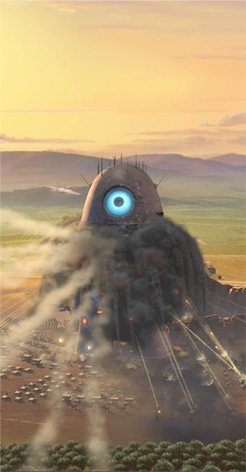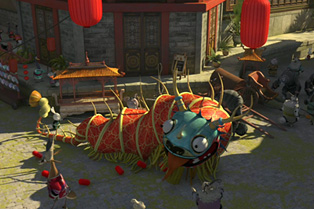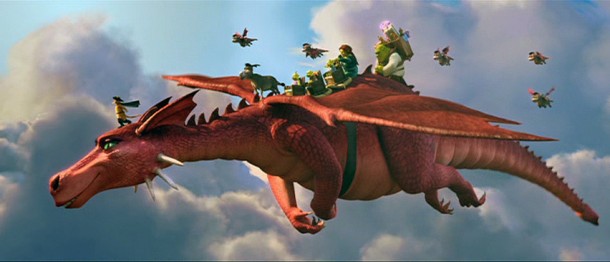Artist Interview: Ricky Baba
What do you think the industry will be like in the coming years, in terms of technology and artistry?
 In the film industry specifically, I think it can learn a lot from video game technology. The stuff that I am seeing in video games, upon close inspection might not be as polished as feature films. However, the real time aspect of games is fantastic, and I think feature film can learn a lot from this. Real time tools are great for let’s say, lighting a shot. Waiting for a render just feels too passive. It would be great to know what you are getting with shadows, reflections etc. before you commit to a render. I realize that there are probably proprietary interactive lighting tools available at major studios. I personally haven’t played with any though. I am working on a character right now, and he is covered in hair. It would be great to do real time accurate grooming of the hair and fur. That would allow for more experimentation and definitely less frustration.
In the film industry specifically, I think it can learn a lot from video game technology. The stuff that I am seeing in video games, upon close inspection might not be as polished as feature films. However, the real time aspect of games is fantastic, and I think feature film can learn a lot from this. Real time tools are great for let’s say, lighting a shot. Waiting for a render just feels too passive. It would be great to know what you are getting with shadows, reflections etc. before you commit to a render. I realize that there are probably proprietary interactive lighting tools available at major studios. I personally haven’t played with any though. I am working on a character right now, and he is covered in hair. It would be great to do real time accurate grooming of the hair and fur. That would allow for more experimentation and definitely less frustration.
What movie inspired you to get into CG and animation?
CG was an accident; I never wanted it at first. I got my first capable computer when I was 23, after graduating college. I rarely touched computers before that. I studied Classical Animation at Sheridan College. What inspired me to want to be a great traditional artist were probably The Lion King and Aladdin, along with the rest of the animated movies at that time. I was drawing my whole life, but I wanted to apply it to something. I did not want to be a ‘starving artist’. Like many parents, mine wanted me to be a Doctor or an Engineer. I was definitely preparing for that in high school. I was very academic. However, I decided to pursue the arts & animation. I always excelled at art. My 10th grade art teacher told me that I should go to Sheridan College. I didn’t know where it was, or what it was. I just kind of dismissed it, I was thinking ‘ok, well whatever. I’ll just continue doodling’. At the last minute, I just decided to go for it. I never did it for the money. I did not know that there was much money in it at all. I just knew that I wanted to make movies.
How do you feel about Gnomon?
I love Gnomon! The truth is that I learned the basics of CG from Gnomon DVD’s. I also did tutorials from a Maya book that I found at the book store. I learned the fundamentals in my bedroom from 2 Gnomon DVD’s and that book. I think it was Texturing and Modeling DVD’s. Old school tutorials, but the core concepts were there. I went through it all, and those skills helped me make the transition from the Art Department at my job, to a full CG artist position. I was at Starz Animation at the time back in Toronto. To be very honest, I was insecure about the fact that I did not continue my education in school. All of my classmates went on to study Computer Animation, and I decided to take a job in an Art Department instead. Gnomon DVD’s are what got me started in CG and took some of that initial fear and mystery out of Maya. Also, I must thank my old employer and fellow co-workers for guiding me and giving me the opportunity to develop my skills on the job.

What makes a good artist in your opinion?
That’s a tough one. I would say that a good artist is someone with a critical eye towards their own work. Having the ability to see what looks bad, or essentially, not good. Knowing what looks appealing is something internal and inherent within the person, and sometimes it can’t be vocalized. Your artistic fingers do the talking. It’s when you do something unappealing, that negative feedback in your brain is triggered, and you eventually stop doing these ‘bad’ things. The result is that you and people around you, just think that you are a ‘good’ artist at that point. So I think becoming a great artist is a combination of weeding out bad artistic habits and techniques. In the meantime, develop your own style through experimentation. This comes with dedication, focus and practice. Being your own best and worst critic is key. Knowing that you have failed in some aspects of your artwork, and you were successful in others. Focus on the successful and eventually, being good becomes a habit. People will think that you have the magic touch and you can do no wrong- when in fact, it took a lot of wrongs to make things right.
How do you stay motivated day in and day out?
Motivation is not a constant linear thing for me. I find that a strong motivator for me is pressure and deadlines. I can track that back to my childhood when my 4th grade teacher told me that I was a ‘procrastinator’. I didn’t know what that meant at the time, but she was kind enough to define it for me. Cool subject matter is also a good motivator. When I have a vested interest in what I am working on, I get motivated. For example, some people really love cars. Those are the kind of CG artists that might be motivated to model cars. Conversely, many animators love to work on subtle character animation, but for a month they might have to animate walk cycles. It would be really difficult for that animator to stay completely motivated throughout that task. In a studio environment, you can’t always get the tasks that you want. Unless you’re an absolute rock star and you can demand whatever you want. That can be a poor attitude to have though. Me personally, I don’t always get what I want. Sometimes I have to texture something that I am not excited about. This occurs in-between getting the ‘hero’ or main characters and environments. Just knowing that you will get to do what you want eventually is motivation. Strive to do a good job across the board consistently. If you don’t enjoy a particular task, try to smile and do your best, they are paying you to do the job. I’m not motivated all of the time to be honest. I just know that I have a job to do and I have to be professional about it. Personal life can get in the way as well. You have to try to put that aside and do what you have to do. Sometimes you feel it, sometimes you don’t. Either way, you must be professional about it.
How difficult is it to transfer over from one position to another in DreamWorks?
It can be difficult. When you get hired, it says on your contract what your specific position is. You got hired because you were the best at what you do at that time. Let’s say that I wanted to transfer to modeling, I would leave an open position in my current department. DreamWorks would have to spend money recruiting new talent, possibly incurring relocation and legal fees moving them from their homeland somewhere else in the world. The shows are cast very tightly. If they need 5 artists in 1 department on a show, they can’t lose that 1 person. They cast for skill levels within that department as well. Of that 5, they might need 2 senior artists, 2 mid-level artists, and 1 junior artist. This is also in-line with the budget. You can’t have every senior artist on one show, and all junior artists left to finish the others. It’s not balanced that way in terms of budget or skill level. If I left my current department (Surfacing), I would leave a senior level position open, and based on my modelling skills, would probably take an entry-level position in modeling. So DreamWorks would be looking to fill a Senior Surfacing artist position, and would have to train someone all over again, just because I wanted to be in Modeling. I’m not saying it can’t be done. However, a new contract must be drafted, and a new salary and job position title would be involved. Some artists are good at many things. However, realize that in a big studio you have a contract that you signed, stating what it is you will be doing. Respect that, but let them know you are interested in other things to get the ball rolling.
 How has stereoscopic or 3d Movies effected your surface texturing?
How has stereoscopic or 3d Movies effected your surface texturing?
When they first introduced the idea of making stereoscopic movies, it seemed like a big deal at the time. In terms of Surfacing, I was wondering ‘how is this going to look in 3D?”. After I saw the first tests, I didn’t think about it too much, if at all. As long as the quality of work remained high, I didn’t worry about how it would look in stereo. There are certain time’s when you might want to think about bump vs. displacement, or hero treatment. Typically I do a ‘first pass’ on an asset, not knowing exactly how it will be used. I won’t waste time putting insane amounts of detail, because It could never be seen up close. Then maybe in Lighting, we find out that the asset is really close to the camera and I have to do a ‘hero pass’ on it. Doing a ‘Hero’ pass is when you go back and revisit it so that it holds up. This can be a time to paint a nice displacement instead of that bump.
Do you remember a point in your life when you hit a level of artistry and it just hit you like a ton of bricks?
It’s usually after the fact. Not in the moment. I think the moment that I peaked in terms of artistry was with drawing, not with CG. There are some people doing some crazy stuff out there, with Z Brush for example. I haven’t peaked like they have with CG. You know what? They probably don’t think that they have peaked either. When I look back at my drawings from college when I was 21 years old, I don’t even remember doing them. I don’t even know how I was able to draw so well. It is a skill, and you can lose it. It’s not like riding a bike. I can’t say that I can draw like that anymore because I have been focusing on my CG career. When I was looking back at my 2D portfolio, I had one of those ‘ah-hah’ moments where I thought ‘wow, I could really draw’.
What artists do you look up to or admire?
I admire the artists that create the movies that I go and watch. When I see trailers for movies with crazy visual effects, I am amazed at the quality of work being done. I look at the trailer for Transformers, and I think ‘wow, who are these guys’. They are extremely talented. I admire the people out there, that are in the industry, doing what they do.
How different was it working on Kung Fu Panda 2 than other movies?
As far as pipeline and tools go, they evolve. It doesn’t affect my workflow too much though. Kung Fu Panda 2 was very challenging because I was assigned a  huge task. My supervisor asked me to setup the Surfacing for the entire city in the movie. There were a few other great artists helping me, but I was responsible for the initial setup. This involves coming up with a solution to keep all of the texturing across every building consistent, no matter which artist it is. It’s more difficult than it sounds. I’ve never had to deal with as many large assets like that before on other movies. So I would say that every project I work on, the responsibility gets increased. This is a good thing. It implies that I am maturing as an artist.
huge task. My supervisor asked me to setup the Surfacing for the entire city in the movie. There were a few other great artists helping me, but I was responsible for the initial setup. This involves coming up with a solution to keep all of the texturing across every building consistent, no matter which artist it is. It’s more difficult than it sounds. I’ve never had to deal with as many large assets like that before on other movies. So I would say that every project I work on, the responsibility gets increased. This is a good thing. It implies that I am maturing as an artist.
What advice would you give to students trying to get into a major studio like Dreamworks?
One thing that they probably don’t teach you in school is to be nice to everybody. My first job that I got was through an ex classmate referral. My second job was through a referral from someone that I didn’t even know very well. He must have respected my work ethic and thought I would be a great fit. When studios are looking to hire, sometimes they ask current employees if they know anybody that’s good before they even look at outside reels and resumes. Your portfolio gets you noticed, but what can get you in the door, is your personality. Even if you do submit your portfolio anonymously, sometimes the supervisors will ask around if anybody knows you. This is where a positive referral will get you an interview at the very least. It definitely accelerates the hiring process. My second word of advice is to give 110% effort in school. In most cases, you are only a student once in your life. Make it count. Have fun at school. Talk to your classmates. Stay up late with people. Enjoy it. Be the best. If you’re not the best, surround yourself with the best. Eventually you will be one of them.
Ricky, can you give any advice to foreign students trying to find work in America and get a green card?
My advice to foreign students is to let your work do the talking. Worry about the geography later. I remember back in 2004, I sent my reel out to every major studio in the US. I was living in Toronto at the time. I got rejected by every single studio except for one. Rhythm & Hues called me and said that they wanted me a.s.a.p. to work on Superman Returns. I had a second phone interview where I was asked when I will be back in LA. They thought I was American, or lived in the US for some reason. When they found out I was Canadian, they told me that they did not have time to get me a work visa. What I learned from this is that it can be beneficial to not broadcast where you are from on your reel. Your email address is often enough. A phone number is ideal though, luckily Canada and the US have the same country code, so it all looks the same. At least you won’t be excluded before you even get contacted. Although I was heartbroken that R&H didn’t take me at the time, at least I knew that I was good enough – regardless of where I was from. That in itself was worth a lot.
What is the internship program at DreamWorks like and is it a paid internship?
I am not familiar with any artistic internship at DreamWorks. There is a program called ‘Outreach’ though. They hire students out of school and give them long-term contracts. I think 4 year contracts in full-time artistic positions. This is not a temporary gig during summer breaks; this is for graduates who are ready to start their careers.
Ricky Baba’s IMDB
Ricky Baba’s Website
About Jose Trujillo
I have always been involved in art since I could remember. I knew that I wanted to be a cg artist when I saw Toy Story and even more so when I saw other movies like Shrek. Prior to attending Gnomon, I graduated with an AA in Multi-Media from ITT Technical Institute. Afterwards, I was a stay at home dad who worked from home. Thanks to the support of my family, I am now able to attend Gnomon. I can’t wait to graduate and start working.
What Jose Trujillo thinks of Gnomon School of Visual Effects
Ever since I took part-time classes at Gnomon, I realized that I loved the school and what it stood for, so I decided to join the two-year program at Gnomon. Gnomon concentrates heavily on what’s important and cuts out any classes that would not be relevant to ones chosen career path. Gnomon takes a practical stand point and gets you to where you want to be in: a perfect balance of time and education. Also, Gnomon is ahead of its time and is constantly adapting to the entertainment industry. The school is structured so the same professional artists who work in the industry are the same ones who teach you. I feel that Gnomon is a opportunity of a lifetime and it will allow me to be able achieve my dream of being a professional CG artist.
Why Jose Trujillo wanted to interview Ricky Baba
Aside from being an exceptional surface artist and animator – or the fact that he works at DreamWorks – I wanted to interview Ricky Baba because he is also a great guy. We met around four years ago and although I was not working in the industry or going to school, Ricky was a great mentor to me and gave me advice and tips on modeling and texturing. He was always kind and courteous and willing to help. I’ve learned a lot from him. I hope to follow in his footsteps and be just as generous with sharing my knowledge and experience as he was with his.
I would like to thank Ricky for allowing me to interview him and also for inviting me into DreamWorks. That was a dream come true for me and it was amazing! Also thanks to Travis Bourbeau, this interview would not have happened if it wasn’t for you, Thanks.

















